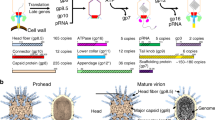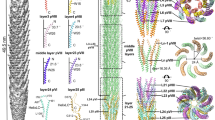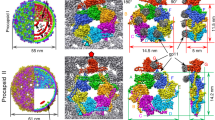Abstract
RECENT studies have revealed that the packaging of DNA into phage heads is an ordered sequence of structural and biochemical events rather than a simple, spontaneous self-assembly of component molecules. In the assembly of T7 for example1, heads containing the products of genes 8–10 and 14–16 are apparently formed first. Gene 9 protein is removed from the heads before or during the incorporation of DNA. At least two other gene products which play no direct structural role are required for the maturation of the heads. A somewhat similar situation exists for phage λ, which has been shown to require ATP for the in vitro packaging of DNA into preformed heads (petite λ)2.
This is a preview of subscription content, access via your institution
Access options
Subscribe to this journal
Receive 51 print issues and online access
$199.00 per year
only $3.90 per issue
Buy this article
- Purchase on Springer Link
- Instant access to full article PDF
Prices may be subject to local taxes which are calculated during checkout
Similar content being viewed by others
References
Studier, F. W., Science, 176, 367–376 (1972).
Kaiser, D., Syvanen, M., and Masuda, R., J. molec. Biol., 91, 175–186 (1975).
Kurata, M., Stockmayer, W., and Roig, A., J. Chem. Phys., 33, 151–155 (1960).
Kaiser, D., Tabor, H., and Tabor, C. W., J. molec. Biol., 6, 141–147 (1963).
Scruggs, R. L., and Ross, P. D., Biopolymers, 2, 593–609 (1964).
Shapiro, J. T., Leng, M., and Felsenfeld, G., Biochemistry, 8, 3219–3232 (1969).
Maniatis, T., Venable, J. H., and Lerman, L. S., J. molec. Biol., 84, 37–64 (1974).
Evdokimov, Yu. M., Platonov, A. L., Tikhonenko, A. S., and Varshavsky, Yu. M., FEBS Lett., 23, 180–184 (1972).
Laemmli, U. K., Paulson, J. R., and Hitchins, V. H., J. supramolec. Struct., 2, 276–301 (1974).
Baxter-Gabbard, K., and Fraser, D., Biopolymers, 13, 207 (1974).
Flory, P., Principles of Polymer Chemistry (Cornell University, Ithaca, New York, 1953).
Lerman, L. S., Proc. natn. Acad. Sci. U.S.A., 68, 1886–1890 (1971).
Hofrichter, H. J., and Schellman, J. A., The Jerusalem Symposia on Quantum Chemistry and Biochemistry, V, (Jerusalem Academy of Science and Humanities, 1973).
Hofrichter, H. J., and Schellman, J. A., J. opt. Soc. Am. (in the press).
Richards, K. E., Williams, R. C., and Calendar, R., J. molec. Biol., 78, 255–259 (1973).
Maestre, M. F., Gray, D. M., and Cook, R. B., Biopolymers, 10, 2537–2553 (1971).
Author information
Authors and Affiliations
Rights and permissions
About this article
Cite this article
GOSULE, L., SCHELLMAN, J. Compact form of DNA induced by spermidine. Nature 259, 333–335 (1976). https://doi.org/10.1038/259333a0
Received:
Accepted:
Issue Date:
DOI: https://doi.org/10.1038/259333a0
This article is cited by
-
A Comprehensive Biophysical Analysis of the Effect of DNA Binding Drugs on Protamine-induced DNA Condensation
Scientific Reports (2019)
-
Specific effects of antitumor active norspermidine on the structure and function of DNA
Scientific Reports (2019)
-
Promotion of homology-directed DNA repair by polyamines
Nature Communications (2019)
-
Repulsive/attractive interaction among compact DNA molecules as judged through laser trapping: difference between linear- and branched-chain polyamines
Colloid and Polymer Science (2019)
-
Photochromic switching of the DNA helicity induced by azobenzene derivatives
Scientific Reports (2016)
Comments
By submitting a comment you agree to abide by our Terms and Community Guidelines. If you find something abusive or that does not comply with our terms or guidelines please flag it as inappropriate.



